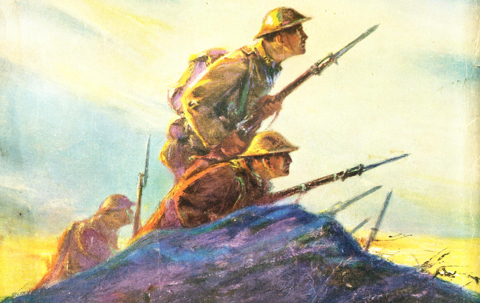 At this year’s convention, PulpFest 2018 will honor the 100th anniversary of the armistice that ended the First World War. Our programming will focus on the so-called “war pulps” of the early twentieth century and the depiction of war in popular culture. The first of these pulps — WAR STORIES — debuted with its November 1926 number. Featuring authors such as Larry Barretto, Robert Sidney Bowen, Harold F. Cruickshank, George Fielding Eliot, Steuart Emery, Arthur Guy Empey, Robert H. Leitfred, Ralph Oppenheim, Alexis Rossoff, and Raoul Whitfield, WAR STORIES demonstrated that tales about soldiers in battle could sell magazines.
At this year’s convention, PulpFest 2018 will honor the 100th anniversary of the armistice that ended the First World War. Our programming will focus on the so-called “war pulps” of the early twentieth century and the depiction of war in popular culture. The first of these pulps — WAR STORIES — debuted with its November 1926 number. Featuring authors such as Larry Barretto, Robert Sidney Bowen, Harold F. Cruickshank, George Fielding Eliot, Steuart Emery, Arthur Guy Empey, Robert H. Leitfred, Ralph Oppenheim, Alexis Rossoff, and Raoul Whitfield, WAR STORIES demonstrated that tales about soldiers in battle could sell magazines.
The war pulps would become a substantial category in the rough-paper industry — particularly with stories about the air war. However, until Dell Publishing launched WAR STORIES, the so-called Great War was rarely explored in the pulps. As Tom Roberts writes in THE ART OF THE PULPS: “Following World War I, the reading public had grown weary from the news of battlefield atrocities. They wished to escape, to forget the realities of the recent conflict; fiction of the European front became taboo, as did war stories in general.”
One author who bucked this trend was Leonard H. Nason. After enlisting in the United States Army in 1917, he was sent to France, serving under General Pershing. He fought in the Meuse-Argonne offensive and was wounded in action. Following the war, Nason found work as an insurance claims adjuster. After marrying in 1920, he turned to writing to earn extra income:
“The only thing I knew well enough to write about was the war. True, millions had been to the war, but many more millions hadn’t, and those who had been in the big fight liked to talk about it, and to hear others talk about it. I had noticed that wherever two or three overseas men got together they invariably began yarning about the war. I had heard some good stories from some of these men, and I had told a few myself that seemed to go over pretty well.”
Nason sent his first tale, “The Patrol,” to ADVENTURE in early 1922. In THE LURE OF ADVENTURE, Robert Kenneth Jones writes, “All the editors in the office . . . enthusiastically embraced it — all, that is, but Arthur Sullivant Hoffmann (the magazine’s editor-in-chief) who questioned its point of view and method of telling.”
Thankfully, Hoffmann relented and accepted the story, sending its author a check for fifty dollars. Included with the payment was a note suggesting that ADVENTURE was not in the market for additional stories about The Great War. After unsuccessfully trying his hand at stories about “pirates and buried treasure and cowboys and Chicago gunmen,” Nason returned to the trenches of Europe.
“ADVENTURE had said they wanted no more war stories. That was all right, but I had to write war stories, so I sat down and wrote an account of my first battle. . . . I decided to set it down just as it had happened, and then it sounded all right. In other words, it was sincere. The incidents fell naturally into place and the story rang true. . . . I had to write about the war as I knew it, or not at all. I couldn’t doctor my stories, color them, fix ’em up to read the way I might have wished they had happened. I had to write them just as they were, maybe adding a little here and taking out a little there, but leaving the essential truth and incidents just as they had come to me.”
It wasn’t long before Nason’s stories were being noticed by readers. One letter-writer to ADVENTURE remarked, “You have certainly made a find in young Nason, as his stories are so natural as to be classed almost as facts.” Even today, the author’s work rings true. According to pulp fan and historian, Walker Martin, “His work is just not about World War I, but about men and how they deal with the horrors of war.”
Join PulpFest 2018 on Thursday, July 26, at 8:40 PM as Sai Shankar looks at this substantial but largely forgotten author at the DoubleTree by Hilton Hotel Pittsburgh – Cranberry. You can join PulpFest by clicking the Register for 2018 button on our home page. And don’t forget to book a room at the DoubleTree. They’re going fast!
(Sai Shankar is a resident of Washington state, where he works in the computer industry. He explores pulp magazines, authors and their stories on Pulp Flakes. You’ll also find photographs from the pulp conventions that he attends on the same site.
Between 1922 and 1928, Leonard H. Nason published over seventy articles and stories in ADVENTURE. Beginning in 1926, he found another steady market for his work in THE SATURDAY EVENING POST. His stories also appeared in THE AMERICAN LEGION MONTHLY, BLUE BOOK MAGAZINE, COLLIER’S, THE COUNTRY GENTLEMAN, FAWCETT’S BATTLE STORIES, LIBERTY, and other magazines. His novella, “Three Lights from a Match,” appeared in the February 20, 1924 issue of ADVENTURE. The issue featured front cover art by H. C. Murphy. It was one of very few ADVENTURE covers depicting The First World War.
For a look at our entire programming schedule, please click the Programming button below the PulpFest banner on our home page.)







